Northern Arizona University
Cline Library
Archival Internship Announcement
2017-2018 Collier Internship
The Cline Library at Northern Arizona University invites applications for The Collier Internship.
The 2017-2018 Collier intern will inventory, digitize, and describe photographs (transparencies, negatives, prints, digital) created by physician and photographer Michael Collier. Collier has been photographing regionally, nationally, and internationally at significant locations since 1970 and has amassed a significant body of work that speaks to his passion and strengths as a photographer. Highlights include photographs of numerous national parks (such as Grand Canyon, Yellowstone, Grand Tetons, and Death Valley); geologic features (such as Alaska glaciers, California faults, and Mount St. Helens); and portraits of individuals.
Duties and Opportunities: The 2017-2018 Collier intern will work closely with Collier and Cline Library’s Special Collections and Archives (SCA) staff to assist in the preparations for the eventual transfer of Collier’s photographic legacy to SCA. Tasks will include inventorying physical collections (slides, negatives, and prints) in Microsoft Excel; digitizing and editing a selection of transparencies; and enhancing descriptive metadata (locations, subjects) using Library of Congress-approved authorities.
This internship offers the opportunity to gain practical experience in:
• Archival arrangement and description and the use of controlled vocabularies
• Contextual research and effective communication of Collier’s work to others
• Digitization and use of related hardware/software
• Photographic creation, editing, and organization
• Independent and collaborative projects
Most work will take place at Collier’s office in downtown Flagstaff, with periodic work at Cline Library. Transportation to Collier’s office is the responsibility of the intern.
The Collier intern will work 364 hours over the course of the academic year (or 36 weeks) and on average 10 hours/week. Hours can be flexible. The intern will earn $12/hour, paid bi-weekly through the academic year.
The internship is expected to begin early in the Fall 2017 semester. Depending on financial resources and/or project success during the first year, the internship may be extended an additional year.
Qualifications: Currently enrolled NAU students (undergraduate and graduate) are encouraged to apply. Candidates should have a demonstrated interest in photography, communications, geography, information science, or another related area.
Knowledge, Skills, Abilities Required:
• Strong ability to analyze visual data while employing advanced research skills
• High level of detail and organization
• Advanced communication skills (oral, written)
• Ability to work independently and as part of a team
• Basic experience with Microsoft Office products
Knowledge, Skills, Abilities Preferred:
• Demonstrated experience with digitization hardware and software
• Knowledge of Colorado Plateau and Southwest history
• Understanding of photographic and print making processes
• Familiarity with archival practice
Application Deadline: Open until filled or the end of the spring 2017 semester. To apply, submit the following documents to: Peter Runge, NAU Cline Library, Box 6022, Flagstaff, AZ 86011-6022 or email Peter.Runge@nau.edu:
• Résumé or vita
• Letter of application addressing your qualifications
• Copy of current transcript
• Names and contact information for three references
For more information, contact Peter Runge at peter.runge@nau.edu or (928) 523-6502.
The mission of Cline Library’s Special Collections and Archives Department is to collect, preserve, and make available archival materials that document the history and development of the Colorado Plateau. Interdisciplinary in nature, the collections include 7 million manuscripts, 1 million photographs, 35,000 books, 2,000 maps, and 1,300 oral histories. Learn more at http://archive.library.nau.edu.
NAU has a growing and diverse student population and is a committed Equal Opportunity/Affirmative Action Institution and Employer of National Service. All qualified candidates are encouraged to apply.














